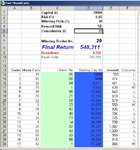TheBramble
Legendary member
- Messages
- 8,394
- Likes
- 1,170
Re-reading Taleb's "Fooled by Randomness" and there is something in there which relates strongly to a number of recent discussions in this group on trade size, probability, stop-loss and general trend derivation. (Which is why I've started a new thread rather than try and 'fit' it into an existing one).
Scenario:
You strongly believe that your index/market/stock of choice today has a 70% chance of rising and a 30% chance of falling AND if it goes up, it;'ll go up by say 1% and if it falls, it'll most likely do so by as much as 10%.
Question 1:
Are you Bullish or Bearish that index/market/stock?
Question 2:
What would your trading strategy be?
Scenario:
You strongly believe that your index/market/stock of choice today has a 70% chance of rising and a 30% chance of falling AND if it goes up, it;'ll go up by say 1% and if it falls, it'll most likely do so by as much as 10%.
Question 1:
Are you Bullish or Bearish that index/market/stock?
Question 2:
What would your trading strategy be?

